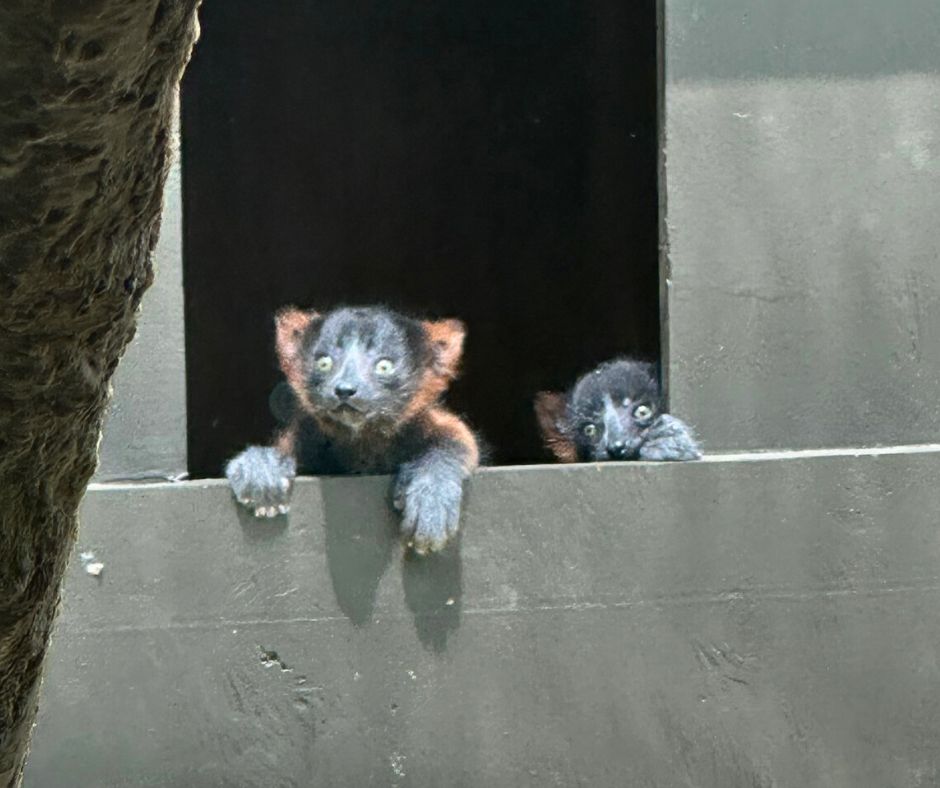
- VisitSupport Happy HollowDONATE TODAYExploreSupport Happy HollowDONATE TODAYLearnSupport Happy HollowDONATE TODAYSupport
-
Today's Hours: 10:00 am to 5:00 pm
Happy Hollow Blog
Jumping for Joy! Happy Hollow Park & Zoo Welcomes Two Baby Red-Ruffed Lemurs
June 6, 2023

Ally the red ruffed lemur became a first-time mom at the zoo on a very special Mother’s Day weekend.
Happy Hollow Park & Zoo welcomes the first red-ruffed lemur pups born at the zoo since 2009, and the two adorable new additions are already doing their part to keep their critically endangered species going strong.
The pups, two males, were born on Friday, May 12, to mom Ally and dad Razoky. At 6 and 14 years old, respectively, this is the first litter for both lemur parents. Red-ruffed lemurs have a highly seasonal breeding pattern, with breeding in facilities in the U.S. taking place from December to January and births in April or May.


As part of the Association of Zoos and Aquarium’s Ruffed Lemur Species Survival Plan, Ally was recommended to transfer from Nashville Zoo to Happy Hollow in November of 2020 as a mate for Razoky. Through Species Survival Plans, expert advisors from the Association of Zoos and Aquariums recommend breeding pairs and transfers of animals between accredited zoos based on genetic information and individual animal’s history. This ensures that the population of a species in human care is as genetically healthy as possible. Currently, 18 of Happy Hollow’s over 50 species of animals are part of a Species Survival Plan.
“The animal care team has been keeping a close eye on the pair since Ally arrived at Happy Hollow,” says Amber Rindy, Happy Hollow Zoo Manager. “Happy Hollow is proud to be a long-time participant in the Ruffed Lemur Species Survival Plan, and very excited to have a successful birth this year!”

Red-ruffed lemurs are listed as critically endangered by the International Union for Conservation of Nature. In the wild, they are found only in a small portion of northern Madagascar and face severe habitat loss due to human agriculture and climate change. The birth of two healthy pups at Happy Hollow is great news for this species in peril, as the pups will not only increase their species’ population but also help zoo visitors learn about the species and make a connection that can lead to conservation action.
“Viewing a wild animal in a zoo setting allows guests to create a connection that may not be possible otherwise,” says Happy Hollow General Manager, Kiersten McCormick. “Very few people may have the opportunity to visit Madagascar and see lemurs in the wild. By visiting our red-ruffed lemur habitat at Happy Hollow, guests can see these unique animals up close and learn about their species and the threats they face.”
Currently, Ally and her pups have access to an off-view den for quiet bonding, but she has already brought them out to spend time in the main habitat. Lucky guests may catch a glimpse of them in their outdoor nest box or moving through the tall grass.

“Both pups are bright and alert and are gaining weight daily, which is a sign of good health at their age,” says Rachel Atkins, Happy Hollow’ Veterinary Technician. “Ally is doing very well as a first-time mother, keeping a close eye on her pups and already reigning in some of their rambunctious and risky behavior, like trying to climb out of the den box without her.”
The public will eventually have the opportunity to help name the new lemur pups through a naming contest. More information on how to participate will be shared through the Zoo’s website and social media in the coming months.
You can see Happy Hollow’s three species of lemurs inside the two different Zoo areas: Zoo on the Hill and Zoo in the Hollow. Happy Hollow is currently open seven days a week from 10 a.m. to 5 p.m. Reservations are not required, but online ticket purchase is available. Plan your visit at www.happyhollow.org
